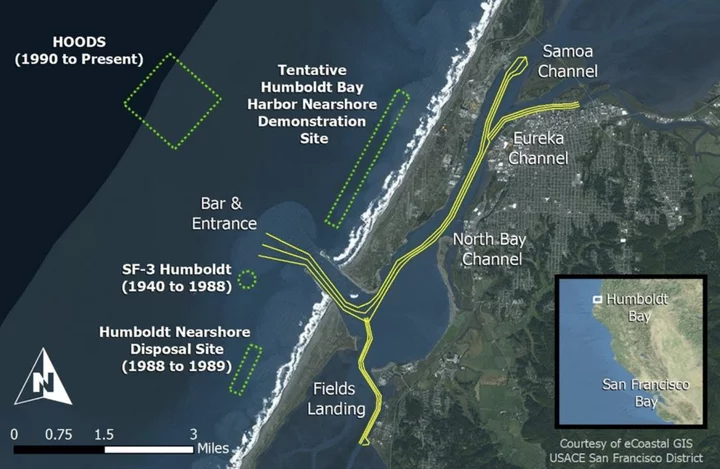Image: U.S. Army Corps of Engineers
###
The U.S. Army Corps of Engineers and the Environmental Protection Agency (EPA) have been hard at work in recent years looking for an eco-friendly and efficient way to get rid of the sand and silt that clogs the shipping channels and harbors of Humboldt Bay.
For the last 30 years, that place has been HOODS – the Humboldt Open Ocean Disposal Site, a square-shaped patch of sea located approximately three miles offshore. The EPA expanded the site a few years back to accommodate more dredged material, with hopes to establish a secondary site a little closer to shore in the near future.
The Humboldt Nearshore Pilot Placement Project seeks to divert sandy, dredged material found in the entrance channel to Humboldt Bay to a nearshore site off the North Spit, rather than disposing of it way out in the ocean.
“By diverting material away from HOODS, we can keep sediment in the littoral system, mitigate erosion along the North Spit of Humboldt Bay, and extend HOODS’s lifetime,” Savannah Fahning, Environmental Manager for the U.S. Army Corps of Engineers’ San Francisco District, told the Outpost. “An important part of this pilot effort will be to monitor the placement of the material and evaluate both the environmental effects and benefits. … HOODS has had issues with sand mounding leading to closure. A nearshore site is a pathway to reduce the demand on this site, while also nourishing the nearshore environment.”
The proposed area, located north of the jetty, would be close enough to the shore to accommodate onshore transport of material, Fahning said, without presenting a navigational hazard. The nearshore site has the capacity to accept roughly one million cubic yards of dredged material annually.
The pilot project would focus exclusively on the entrance channel, Fahning said, due to the quality of the material.
“In general, marina channels (or inner channels) experience less wave action than entrance channels do, and as such have more of a fine/silty sediment composition,” she said. “Again, this project would take from the entrance channel, which is a very high energy area with large waves and strong current, typically consisting of 85 percent or greater sandy material. … By returning the sediment to the natural flow field, natural processes will be re-enforced and supply of sediment will be returned to the North Spit.”
Researchers have identified an “erosional pattern” on the beaches north of the jetty. While the cause is inconclusive, Fahning said maintaining a natural sediment supply, “instead of removing it entirely from the system to divert to the HOODS site,” could help maintain the beach and reduce impacts associated with sea level rise.
###
The U.S. Army Corps of Engineers, with support from the EPA and Humboldt Bay Harbor, Recreation and Conservation District, will host a town hall discussion on the proposed project on Thursday evening. The meeting will take place at 5 p.m. at the Wharfinger Building, Bay Room – 1 Marina Way in Eureka.
###
Click to enlarge.


CLICK TO MANAGE